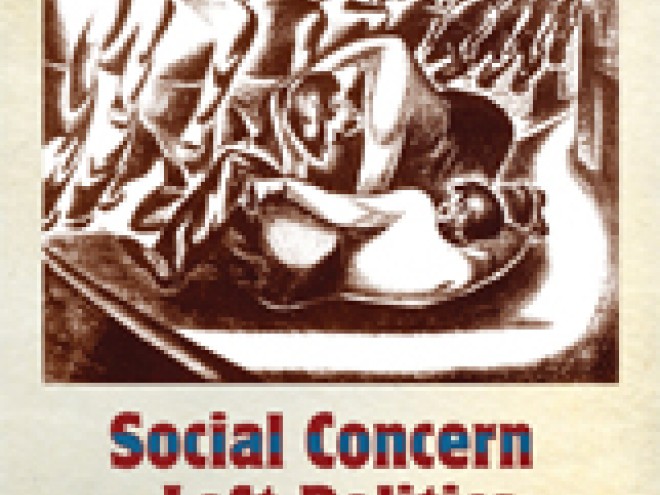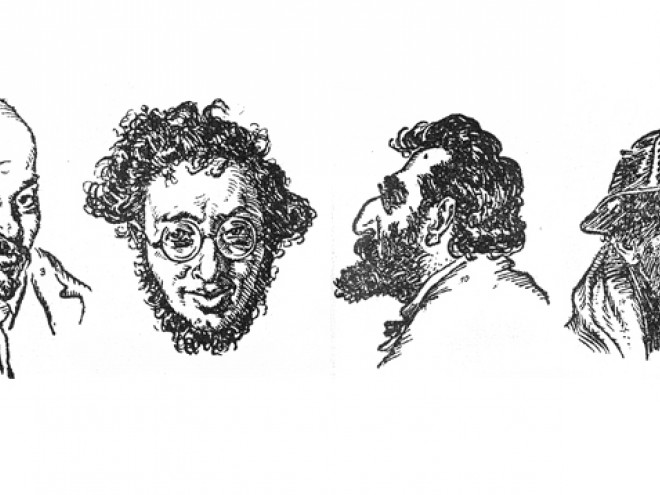
Cover image for Jewish Art in America designed by Archie Rand
Matthew Baigell is professor emeritus in the Department of Art History at Rutgers University. His newest book, The Implacable Urge to Defame: Cartoon Jews in the American Press, 1877 – 1935, was published by Syracuse University Press in April. He will be guest blogging for the Jewish Book Council all week as part of the Visiting Scribe series here on The ProsenPeople.
As an art historian specializing in American art, I had wondered why contemporary Jewish art had been neglected in the mainstream press. True, there are famous artists who are Jewish but they do not explore Jewish subject matter. True, one can find demeaning, cheap-shot humor directed at Jewish subjects. But by Jewish art, I mean subject matter based on religious, historical, and positive cultural sources. By comparison, several Latino/a and African American artists, among other minorities, have, over the last few decades, explored their heritages and have exhibited their works.
What is one to say? An excuse I have heard many times is that too few people are interested in such works. But this is Catch-22 logic. People are not interested because such art is not shown and such art is not shown because people are not interested. I wonder, then, if Jewish art historians, critics, and gallerists must still be embarrassed by their religion, shy away from it, do not want to be identified with it, and want to be identified as mainstream in their tastes. What ever the reasons, artists who explore Jewish subject matter exhibit less and are not as well known as artists belonging to other minority groups. This is not just a question of talent. In my own experience, although the situation is improving, I have been directed to Jewish and Jewish-friendly rather than mainstream publications when submitting or suggesting articles or books on contemporary Jewish subjects or artists. We are still in a ghetto.
I decided at some point in my career (I am now a professor emeritus, having retired about fifteen years ago) to help bring Jewish content to public attention and to make a contribution, however small, to the history of Jewish art in America. My moment came when Norman Kleeblatt, the recently retired curator at the Jewish Museum, asked me to contribute an essay on artists who studied at the Educational Alliance in New York’s Lower East Side for the catalogue of his exhibition in 1991, Painting a Place in America: Jewish Artists in New York 1900 – 1945. Several artists were well known — Max Weber, Ben Shahn, Marlk Rothko, Louise Nevelson — but I soon realized that very little had been written about the artists from a Jewish, rather than mainstream American point of view. I turned in a sixty-page essay that I had to cut in half. But I found my subject, and not just because it is always a great pleasure for a person engaged in research to come on material where there are very few thumb prints of other scholars. . The artists had a Jewish life and several of their works could be more fully understood only in a religious, historical, or culturally Jewish context. To be sure, I had a lot to learn about life in eastern Europe and in the Lower East Side around the turn of the twentieth century as well as about traditional Orthodox practices, but gaining such knowledge became a way to learn more about who my forebears were and something of their world view as well as my own connections to Judaism which over the years have grown increasingly deeper and profoundly satisfying.
After submitting my article for the exhibition, my future scholarly course was set. I began to teach a course in Jewish art and began to write articles and books mostly about religious content in Jewish American art. (I was not am still not interested in artists who are Jewish and paint, say, only landscapes or geranium plants.) So far, that includes six books, two co-edited anthologies and many articles. One is on Holocaust subject matter by Jewish American artists who were quite shy of confronting the material until the 1960s. Another is about Holocaust imagery by European Jewish artists who passed the war years in this country.
When researching material for a survey of Jewish art in America (Jewish Art in America: An Introduction, 2007), another one of those ‘a‑ha’ moments occurred. I realized that toward the end of the 1970s and ever since, we have been living in a golden age of Jewish American art. Artists all over the country had begun to turn to biblical themes, especially Jewish feminist artists, who challenged traditional interpretations through their art. Perhaps more artists than in any previous American generation were creating Jewish-themed works and therefore adding lively and important chapters to the history of Jewish art in this country. Interviewing dozens and befriending several of these artists has been one of the great joys in my professional and personal life, and bringing their work to public attention remains an abiding concern. I don’t want to say an abiding mission because that sounds too inflated, but I feel that it gives my work some purpose.
Check back on Thursday to read more from Matthew Baigell.
Matthew Baigell is professor emeritus in the department of art history at Rutgers University. He is the author, editor, and coeditor of over twenty books on American and Jewish American art. His most recent book is The Implacable Urge to Defame: Cartoon Jews in the American Press, 1877 – 1935.

